|
|
 |
|
Calanoida ( Order ) |
|
|
|
Clausocalanoidea ( Superfamily ) |
|
|
|
Aetideidae ( Family ) |
|
|
|
Euchirella ( Genus ) |
|
|
| |
Euchirella pulchra (Lubbock, 1856) (F,M) | |
| | | | | | | Syn.: | Undina pulchra Lubbock, 1856; Claus, 1863 (p.186);
Calanus latus Lubbock, 1856;
Euchirella orientalis (M) Sewell, 1929 (p.118, figs.M);
Euchaeta pulchra (M) : Brady, 1883 (p.63);
no Euchirella pulchra : Davis, 1949 (p.31, figs.F) | | | | Ref.: | | | Giesbrecht, 1892 (p.233, 244, 772, figs.F,M); Giesbrecht & Schmeil, 1898 (p.36, Rem. F,M); Esterly, 1905 (p.153, figs.F,M); A. Scott, 1909 (p.56, Rem.); Wolfenden, 1911 (p.241); Sars, 1925 (p.69, figs.F); Wilson, 1932 a (p.58, figs.F,M); Lysholm & al., 1945 (p.17); Sewell, 1947 (p.69, 80, figs.F,M); Vervoort, 1949 (p.20, figs.M); Brodsky, 1950 (1967) (p.175, figs.F,M, Rem.); Vervoort, 1952 f (n°47, p.3, figs.F,M); Tanaka, 1957 b (p.178, figs.F,M); Grice, 1962 (p.194, figs.F, Rem.); Paiva, 1963 (p.36); Vervoort, 1963 b (p.145, Rem.); Gaudy, 1963 (p.22, figs.F); Omori, 1965 a (p.64, figs.F, Rem.); Owre & Foyo, 1967 (p.48, figs.F,M); Tanaka & Omori, 1969 (p.55, figs.F,M); Shih & al., 1971 (p.143); Vaupel Klein, 1972 (p.502, 505); Park, 1976 (p.210, figs.F, Rem.); 1976 a (p.116, figs.F,M); Dawson & Knatz, 1980 (p.6, figs.F,M); Bradford & Jillett, 1980 (p.33); Vaupel Klein, 1980 (p.152); Björnberg & al., 1981 (p.605, 632, figs.F); Chahsavar-Archad & Razouls, 1982 (p.28, fig.M); Gardner & Szabo, 1982 (p.236, figs.F,M); Vaupel Klein, 1984 a (p.43, figs.F, Table II: characters, Rem.); Markhaseva, 1996 (p.165, figs.F,M); Chihara & Murano, 1997 (p.686, Pl.37,39: F,M); Bradford-Grieve & al., 1999 (p.879, 921, figs.F,M); Mulyadi, 2001 (p.820, figs.F, Rem.); Conway & al., 2003 (p.175, figs.F,M, Rem.); Mulyadi, 2004 (p.49, figs.F, Rem.); Vives & Shmeleva, 2007 (p.568, figs.F,M, Rem.) |  issued from : Tanaka O. in Publ. Seto Mar. Biol. Lab., 1957, 6 (2). [Fig.45, p.179]. Female (from Sagami): habitus (dorsal aspect); b, head (lateral aspect); c, last thoracic segment and urosome (lateral aspect); d, exopodite, endopodite and lobes of Mx1; e, basal joints of P4. Male (from Suruga): f, head (lateral aspect); g, P5; h, distal joint of exopodite of left P5. Nota Female: - Cephalothorax about 4 times the abdominal length (2.77 : 0.7). - Forehead with a low crest. - Frontal organ prominent. - Rostrum short. - Abdomen 4-segmented; segments and caudal rami in the proportional lengths 52 : 15 : 13 : 5 : 15 = 100. - Genital segment with a swelling on left side; right side indented. - Caudal rami about as long as wide. - A1 23-segmented, extends about to distal end of 3rd abdominal segment. - A2 exopod 2.8 times as long azs endopod; 2nd segment of endopod with 6+6 setae. - Md with exopod about as long as endopod. - Mxp with the two basal segments of about equal lengths; 2nd basal segment with a row of spinules on the proximal anterior margin. - P1 with the outer edge spine of 3rd exopodal segment about as long as the segment itself. - Terminal spine of P2 to P4 with 20, 19 and 19 teeth respectively. - Coxa of P4 with 2 subequal spines at the base of inner marginal seta, and scattered bristles on coxa and basis surfaces. Nota Male: - Cephalothorax about 3.3 times the abdominal length (2.35 : 0.71). - .Forehead with a low crest. - Last two thoracic segments fused. - Rostrum one-pointed. - Abdomen 5-segmented; segments and caudal rami in the proportional length 25 : 23 : 19 : 19 : 2 : 12 = 100. - Distal margin of 2nd and 3rd abdominal segments fringed with teeth. - A1 extends to distal end of 3rd abdominal segment; segments 8 and 9 fused, 12 and 13 incompletely fused. - Mx1 with 3 short and long setae on outer lobe; 10 setae on exopod; 4 setae on endopod. - P1 exopod 3-segmented; 2nd segment of exopod with a minute outer edge spine; articulation between 1st and 2nd segments clearly visible on the anterior surface . - P2 with a completely fused endopod. - P4 without spine on inner disr-tal margin of 2nd segment; inner edge spine of 1st segment of endopod with an accessory spine. - P5 as figured by Giesbrecht.
|
 issued from : T. Park in Contr. Mar. Sci., 1976, 20. [p.116, Fig.7]. Female: a, b, forehead (dorsal, lateral, respectively); c, d, posterior part of metasome and urosome (dorsal, right side, respectively); e, genital segment (left side); f, A2; g, coxa of fourth leg (posterior). Nota: Forehead devoid of a crest - Rostrum well developed. - Posterolateral corners of metasome symmetrical, broadly rounded when viewed laterally. - Endopod of A2 about 1./3.5 length of exopod. Inner and outer lobe of 2nd endopodal segment each with 6 setae. Male: h, i, forehead (dorsal, lateral); j, fifth pair of legs (anterior); k, distal part of left fifth leg (posterior); l, idem (anterior). Nota male : Forehead with a low crest. - Rostrum well developed. - Left P5 without endopod; 1st exopodal not reaching the distal end of right basipodite. 3rd exopodal segment small, together with a similarity small distal process of 2nd, forming a small chela. Both endopod and exopod of right leg tapering into a large spiniform process.. Endopod with 4 processes along external margin, 2 proximal and 2 distal to joint between 2 exopodal segments. Anteriorly, 3 processes are visible on 1st exopodal segment, with 1st process hidden behind proximal part of endopod; 2 of these 3 processes are between first 2 processes of endopod.
|
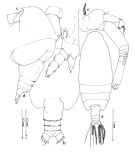 issued from : Mulyadi in Crustaceana, 2001, 74 (9). [p.820, Fig.6]. Female (from Flores Sea): a, habitus (dorsal); b, last thoracic segment and urosome (dorsal); c, forehead (left lateral side); d, 1st thoracic segment and urosome (left lateral side); e, A2; f, P4. Prosome less than 4 times the length of the urosome. The present specimen differs from current descriptions by the absence of a rounded process on the left margin of the genital somite.
|
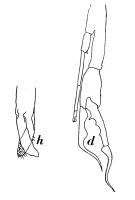 Issued from : W. Vervoort in Zool. Verh., Leiden, 1949, 5. [p.19, Fig.9,h,d]. Male (from Indonesian seas): d, P5; h, terminal part of the left P5. Nota: This male specimen agrees closely with Sewell's (1947, p.80) description.
|
 Issued from : G.O. Sars in Résult. Camp. Scient. Prince Albert I, 69, pls.1-127 (1924). [Pl.XX, figs.5-7]. Female: 5, habitus (dorsal); 6, basipodal segment of P4; 7, forehead (lateral).
|
 issued from : R.B.S. Sewell in The John Murray Expedition, 1933-34, Scientific Reports, VIII (1), 1947. [p.81, Fig.16]. Female (from Arabian Sea): A, urosome (lateral right side); B, Mxp; C, P4 (incomplete). Nota: Proportional lengths of cephalothorax and abdomen as 79 to 21. The proportional lengths of the various segments of the body (cephalon to caudal rami) as 396:134:99:84:74:94:36:26:26:31= 1000. Head and 1st pediger segment separate, 4th and 5th fused. The genital segment presents a rounded swelling on the left side and a well-marked ventral protrusion. A1 23-segmented (segments 8-9 and 24-25 respectively fused) reaches back to the end of the thorax. Endopod of A2 very short, reaches only to a little beyond the middle of the 1st segment of exopod. In Mx2, 2 nd inner lobe with 4 stout setae, 3rd inner lobe with 2; 2nd basal segment with 2 setae at its distal inner angle, the proximal of which is delicate; endopod with 4 setae. Male: D, P1; E, P5. Nota: The proportional lengths of the various segments of the body (cephalon to caudal rami) as 476:79:79:95:79:60:52:44:8:28= 1000. Forehead with a very low crest. Head and 1st pediger segment fused, 4th and 5th fused. Anal segment almost completely telescoped into the 4th segment. Right A1 19-segmented (8 to 10, 12-13, 14-15, 20-21 and 24-25, respectively fused) fused; left 20-segmented (segments 20 and 21 separate).
|
 issued from : J.C. von Vaupel Klein in Crustaceana, Supplt 9, Studies on Copepoda, III, 1984. [p.42, Fig.2, b, c]. Euchirella pulchra f. pacifica. Female: b, smoothly depressed forehead (left lateral side). Euchirella pulchra f. typica. Female: c, angular outline of the forehead (left lateral side).
|
 issued from : J.C. von Vaupel Klein in Crustaceana, Supplt 9, Studies on Copepoda, III, 1984. [p.42, Fig.2, d, e, f]. Euchirella pulchra f. pacifica. Female: d-f, genital somite (left lateral, dorsal and right lateral, respectively). Nota: Note antero-lateral extension of ear-shaped lobe on the left (as opposed to the exclusively lateral proliferation in Atlantic specimens), as well as the definite dorso-lateral ridge on the right.
|
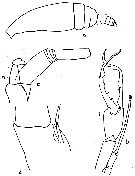 issued from : C.O. Esterly in Univ. Calif. Publs Zool., 1905, 2 (4). [p.154, Fig.20]. Female (from San Diego Region): a, habitus (lateral); c, A2 (bristles omitted; ri = endopodite); d, basiopite 1 of P4. Nota: Front with low crest and small rostrum. Genital segment asymmetrical, left side strongly convex in front of the middle of the, right side indented. segment Male: b, P5.
|
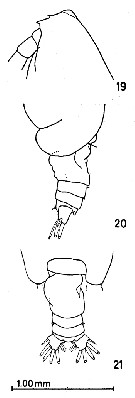 issued from : M. Omori in J. Oceanol. Soc. Japan, 1965, 21 (2). [p.64, Figs.19-21]. Female: 19, forehead (lateral); 20, posterior prosome and urosome (left lateral); 21, idem (dorsal). Nota : A trace of a crest on the head. Genital segment with a protuberance on the left side
|
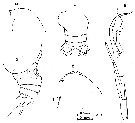 issued from : O. Tanaka & M. Omori in Publ. Seto mar. Biol. Lab., 1969, XVII, 1. [p.55, Fig.8]. Female (from W Pacific): a, forehead (lateral); b, last thoracic segment and urosome (lateral); c, urosome (dorsal). Male: d, forehead (lateral); e, P5; f, left P5 (distal segment of exopod).
|
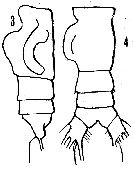 issued from : R. Gaudy in Rec..Trav. Stn mar. Endoume, 1963, 45, Bull. 30 (45). [p.40, Pl.I,, Figs.2-3]. Female (from 27°34'S, 47°00W): 3-4, urosome (lateral and dorsal, respectively). Nota: genital segment with characteritic protuberance on the left side.
|
 issued from : G.D. Grice in Fish. Bull. Fish and Wildl. Ser., 1962, 61. [p.195, Pl.10, Figs.1-4]. Female (from 01°10'S, 134°57'W):1-2, habitus (latezral and dorsal, respectively); 3, endopod of A2; 4, P4. Nota: Genital segment produced into a rounded swelling to the left. 2nd segment of the endopod of A2 with 6 setae on each lobe (Giesbrecht & Schmeil, 1898, and Vervoort, 1952, stated yhat the internal lobe has 5 setae; possibly the very small, innermost seta on the internal lobe was overlooked). Presence of 2 spines on the 1st basipodal segment of P4.
|
 issued from : J.C. von Vaupel Klein in Crustaceana, Supplt 9, Studies on Copepoda, III, 1984. [p.80, Fig.16, j, k, v]. Female: j, terminal seta of P3 (17teeth); k, terminal seta of P4 (19 teeth); v, arrangement of medial spines on the posterior face of basal segment 1 of left P4 (2 slightly unequal to subequal spines on a common base). Scale bar: 1, 0.1 mm (v); 2, 0.2 mm (J, K).
|
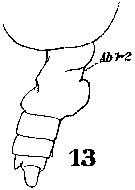 Issued from : W. Giesbrecht in Systematik und Faunistik der Pelagischen Copepoden des Golfes von Neapel und der angrenzenden Meeres-Abschnitte. – Fauna Flora Golf. Neapel, 1892, 19 , Atlas von 54 Tafeln. [Taf.36, Fig.13]. Female : 13, urosome (lateral). Abd 1-2 = genital double-somite.
|
 Issued from : W. Giesbrecht in Systematik und Faunistik der Pelagischen Copepoden des Golfes von Neapel und der angrenzenden Meeres-Abschnitte. – Fauna Flora Golf. Neapel, 1892, 19 , Atlas von 54 Tafeln. [Taf.15, Fig.23]. Female : 23, P4 (posterior view). Ri1 = endopodal segment 1; B1 = coxa; B2 = basis.
|
 Issued from : W. Giesbrecht in Systematik und Faunistik der Pelagischen Copepoden des Golfes von Neapel und der angrenzenden Meeres-Abschnitte. – Fauna Flora Golf. Neapel, 1892, 19 , Atlas von 54 Tafeln. [Taf.36, Fig.27]. Male: 27, forehead (lateral).
|
 Issued from : W. Giesbrecht in Systematik und Faunistik der Pelagischen Copepoden des Golfes von Neapel und der angrenzenden Meeres-Abschnitte. – Fauna Flora Golf. Neapel, 1892, 19 , Atlas von 54 Tafeln. [Taf.15, Fig.22]. Male: 22, P5 (posterior view). Re = exopod; Ri = endopod.
|
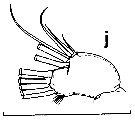 issued from : J.C. von Vaupel Klein in Crustaceana, Supplt 9, Studies on Copepoda, III, 1984. [p.65, Fig.6 j]. Euchirella pulchra: a, Setal armature of endopodte 2+3 of A2. Conditions are expressed are expressed in formulae as follows: number of setae in regular row on proximal lobe / relative development of seta in position no. 9 on this lobe / number of setae in approximately linear row on terminal lobe / relative development of appendicular seta no. 7 and its supporting pedestral (absent, vestigial, moderate or well developed: see Table I, p.87 and Table II, p.93). upper and lower lobes = proximal and terminal lobes (details of right appendage shown in medial aspect. Scale bar = 0.133 mm. Nota: Condition 6/1/6/1 in the (rest of the) pulchra-group..
|
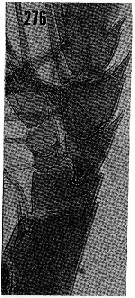 issued from : H.B. Owre & M. Foyo in Fauna Caribaea, 1967, 1, Crustacea, 1: Copepoda. [p.48, Fig.276]. Female (from Florida Current): 276, P4.
|
 issued from : E.L. Markhaseva in Proc. Zool. Inst. RAN, St. Petersburg, 1996, 268. [p.166, Fig.128]. As Euchirella pulchra. Female (from N Atlantic). Nota: Genital segment asymmetrical with large ''ear-like'' swelling on the left and small depression on the right. A1 reaching about end of genital segment, or ursomal segment 3. Endopod of A2 nearly 3 times shorter than exopod; coxo- and basipodite with 1 seta each; both lobes of endopodal segment 2 with 6 setae.
|
 Euchirella pulchra Euchirella pulchra female: 1 - Genital segment asymmetrical. 2 - Crest absent. 3 - Genital segment with left lateral side swelled (dorsal view). 4 - Coxopodite of P4 with 2 spines. 5 - Endopodal segment 1 of Md without seta. 6 - Posteriot part of genital segment without projections (left lateral side). 7 - Endopodal segment 2 of A2 lobes with not less than 6 setae each.
|
 Issued from : T. Park in Crustaceana, 1976, 31 (2). [p.211, Fig.2]. Female: A, habitus (lateral); B, forehead (lateral); C, same (dorsal); D, posterior part of body (lateral); E, last metasomal and genital segments (lateral); F, posterior part of body (dorsal). Nota: Forehead shows no trace of a crest. When viewed laterally, its anterodorsal side is broadly rounded. Dorsally, the forehead is in the form of a low triangle with a rounded apex. - Genital segment strongly asymmetrical-, with a large, somewhat ear-shaped prptuberance on the left side close to the proximal end. The left portion of the dorsal wall of the genital segment, including the protuberance, is conspicuously hollow. Viewed from the right side, however, the dorsal wall of the genital segment is slightly depressed in the middle, with a smoothly curved margin. - Coxa of P4 with 2 strong spines close to the internal seta. The other appendages are similar to those of E. pseudopulchra.
|
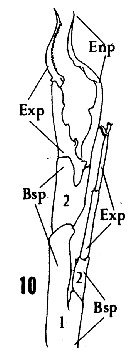 Issued from : H.B. Owre & M. Foyo in Fauna Caribaea, 1, Crustacea, 1: Copepoda. Copepods of the Florida Current, 1967. [p.11, Fig.10]. Male: 10, P5. Bsp = basipodite (1 = Coxa, 2 = Basis); Exp = exopodire; Enp = endopodite.
|
 issued from : Tanaka O. in Publ. Seto Mar. Biol. Lab., 1957, 6 (2). [p.179]. Female A1: proportional lengths of segments. - A1 23-segmented, extends about to distal end of 3td abdominal segment.
|
 Issued from : J.C. von Vaupel Klein in Crustaceana, Supplt 9, Studies on Copepoda, III, 1984. [p.72, Fig.11, b]. Euchirella pulchra. Structure of Mx1, terminal configuration of setae plus the 'blunt tooth (= tubular pore) on the endite of basis (Ba2) (plumosity and/or spinules on setae, as well as hairs on lobe, omitted, right appendage in anterior view). Showing the usual Euchirella complement of, from anterior to posterior: short proximal seta (p), long central seta (c), blunt tooth (dotted outline) and shortest, distal seta (d). Contrary to E. curticauda the proximal seta (p) absent and central seta (c) reduced in E. pulchra.
|
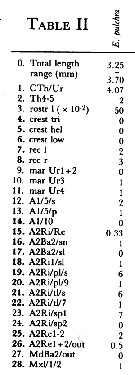 Issued from : J.C. von Vaupel Klein in Crustaceana, (Supplement) 9, 1984. [p.93, Table II ]. Euchirella pulchra Female: Datamatrix stating observed states of characters from Table I (p.87-90) presently examined; nos. refer to the input nos. used in Table I (see to the family Aetideidae).
|
 Issued from : J.C. von Vaupel Klein in Crustaceana, (Supplement) 9, 1984. [p.94, Table II (cont' d) ]. Euchirella pulchra Female: Datamatrix stating observed states of characters from Table I (p.87-90) presently examined; nos. refer to the input nos. used in Table I (see to the family Aetideidae).
|
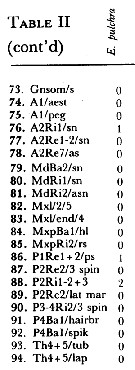 Issued from : J.C. von Vaupel Klein in Crustaceana, (Supplement) 9, 1984. [p.95, Table II (cont' d) ]. Euchirella pulchra Female: Datamatrix stating observed states of characters from Table I (p.87-90) presently examined; nos. refer to the input nos. used in Table I (see to the family Aetideidae).
| | | | | Compl. Ref.: | | | Wilson, 1942 a (p.186); Oliveira, 1945 (p.191); Sewell, 1948 (p.329, 500, 516, 520, 530, 531, 534, 545, 566); C.B. Wilson, 1950 (p.225); Fagetti, 1962 (p.20); Ahlstrom & Thrailkill, 1963 (p.57, Table 5, abundance); Grice, 1963 a (p.495); Gaudy, 1963 (p.22, Rem.); Grice & Hulsemann, 1967 (p.15); Fleminger, 1967 a (tabl.1); Morris, 1970 (p.2300); Park, 1970 (p.475); Lee & al., 1971 (p.1150); Roe, 1972 (p.277, tabl.1, tabl.2); 1972 a (p.339); Bainbridge, 1972 (p.61, Appendix Table III: occurrence); Björnberg, 1973 (p.328, 386); Dessier, 1979 (p.204); Vives & al., 1975 (p.41, tab.II); Deevey & Brooks, 1977 (p.256, Table 2, station "S"); Carter, 1977 (1978) (p.35); Vives, 1982 (p.291); Brenning, 1983 (p.3, 5, spatial distribution, T-S diagram, Rem.); Guangshan & Honglin, 1984 (p.118, tab.); Brenning, 1985 a (p.28, Table 2); Rudyakov, 1986 (tab.1); Heinrich, 1990 (p.17); Suarez & al., 1990 (tab.2); Madhupratap & Haridas, 1990 (p.305, fig.4: vertical distribution night/day; fig.7: cluster); Hattori, 1991 (tab.1, Appendix); Suarez & Gasca, 1991 (tab.2); Suarez, 1992 (App.1); Shih & Young, 1995 (p.67); Padmavati & Goswami, 1996 a (p.85, fig.3, vertical distribution); Suarez-Morales & Gasca, 1998 a (p107); Lapernat, 2000 (tabl.3, 4); Haury & al., 2000 (p.69, Table 1); Holmes, 2001 (p.48); Gallienne & al., 2004 (p.5, tab.3); Hwang & al., 2007 (p.23); Dur & al., 2007 (p.197, Table IV); C.E. Morales & al., 2010 (p.158, Table 1); Hidalgo & al., 2010 (p.2089, Table 2); Medellin-Mora & Navas S., 2010 (p.265, Tab. 2); Pillai H.U.K. & al., 2011 (p.239, Table 3, vertical distribution); Tutasi & al., 2011 (p.791, Table 2, abundance distribution vs La Niña event); Tseng L.-C. & al., 2011 (p.47, Table 2, occurrences vs mesh sizes); Hidalgo & al., 2012 (p.134, Table 2) ; Teuber & al., 2013 (p.1, Table 1, 2, 3, abundance vs oxygen minimum zone, respiration rates, enzyme activity); in CalCOFI regional list (MDO, Nov. 2013; M. Ohman, comm. pers.); Hirai & al., 2013 (p.1, Table I, molecular marker); Hwang & al., 2014 (p.43, Appendix A: seasonal abundance); Bonecker & a., 2014 (p.445, Table II: frequency, horizontal & vertical distributions); Bode & al., 2015 (p.268, Table 1, 2, figs.3, 4, chemical components, trophic level, geographic zone); Bode & al., 2018 (p.840, Table 1, respiration & ingestion rates, depth) | | | | NZ: | 17 | | |
|
Distribution map of Euchirella pulchra by geographical zones
|
| | | | | | | | | | | | 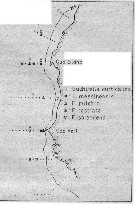 issued from : U. Brenning in Wiss. Z. Wilhelm-Pieck-Univ. Rostock - 32. Jahrgang 1983. Mat.-nat. wiss. Reihe, 5. [p.1, Fig.1]. issued from : U. Brenning in Wiss. Z. Wilhelm-Pieck-Univ. Rostock - 32. Jahrgang 1983. Mat.-nat. wiss. Reihe, 5. [p.1, Fig.1].
Spatial distribution for Euchirella curticauda, E. messinensis, E. pulchra, E. rostrata, E. splendens from 8° S - 26° N; 16°- 20° W. |
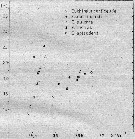 issued from : U. Brenning in Wiss. Z. Wilhelm-Pieck-Univ. Rostock - 32. Jahrgang 1983. Mat.-nat. wiss. Reihe, 5. [p.3, Fig.3]. issued from : U. Brenning in Wiss. Z. Wilhelm-Pieck-Univ. Rostock - 32. Jahrgang 1983. Mat.-nat. wiss. Reihe, 5. [p.3, Fig.3].
T-S Diagram for Euchirella curticauda, E. messinensis, E. pulchra, E. rostrata, E. splendens from 8° S - 26° N; 16°- 20° W. |
 Issued from : M. Madhupratap & P. Haridas in J. Plankton Res., 12 (2). [p.311, Fig.4]. Issued from : M. Madhupratap & P. Haridas in J. Plankton Res., 12 (2). [p.311, Fig.4].
Vertical distribution of calanoid copepod (mean +1 SE), abundance No/100 m3. 36- Euchirella pulchra.
Night: shaded, day: unshaded.
Samples collected from 6 stations located off Cochin (India), SE Arabian Sea, November 1983, with a Multiple Closing Plankton Net (mesh aperture 300 µm), in vertical hauls at 4 depth intervalls (0-200, 200-400, 400-600, 600-1000 m). |
 Issued from : M. Bode, R. Koppelmann, L. Teuber, W. Hagen & H. Auel inGlobal Biogeochemical Cycles, 2018, 32. [p.844, Table 1). Issued from : M. Bode, R. Koppelmann, L. Teuber, W. Hagen & H. Auel inGlobal Biogeochemical Cycles, 2018, 32. [p.844, Table 1).
Cf. explanations of these measures in Calanoides natalis from the same authors.
Compare with Euchirella rostrata, E. curticauda, E. splendens. |
| | | | Loc: | | | South Africa, Namibia, off da Trindade Is., Angola Congo, G. of Guinea, off Lagos, off E St. Paul Is., Cape Verde Is., off Senegal-Mauritania, Canary Is., Ibero-moroccan Bay, S Azores, off W Ireland, North Sea, S Brazil , off Rio de Janeiro, Abrolhos Bank, off Amazon, Barbada Is., Caribbean Colombia, Caribbean Sea, G. of Mexico, Florida, Sargasso Sea, Station "S" (32°10'N, 64°30'W), off Woods Hole, G. of St. Lawrence, G. of Aden, Arabian Sea, Goa - Gujarat, Natal, Madagascar (Nosy Bé), Rodrigues Is. - Seychelles, Indian, Andaman Sea (Batten Island), Pacif. (W equatorial), W Australia, Indonesia-Malaysia, Flores Sea, Philippines, China Seas (East China Sea, South China Sea), Taiwan (SW, S), Pacif. (equatorial), Pacif. (N central subtropical), SE Alaska, Japan (Izu, off Sanriku), British Columbia, California, W Baja California, off Galapagos, Galapagos-Ecuador, off Peru, Pacif. (SE tropical), Chile (N-S, off Santiago, Concepcion).
Type locality: Atlantic (tropical). | | | | N: | 96 (Atlant.: 49; Indian: 14, Indo-Malaysia: 2; W Pacif.: 18; E Pacif.: 11) | | | | Lg.: | | | (1) F: 3,5; (11) F: 3,367; (14) F: 3,7-3,13; (37) F: 4,4-3,04; M: 4,15-3,06; (41) F: 3,55-2,9; (45) F: 4,4-3,4; M: 3,75-3,5; (46) F: 4,4; (47) M: 3,7; (56) F: 3,47; M: 3,06; (73) F: 3,64; (101) F: 3,42; (110) F: 3,5-2,88; M: 3,15-3,09; (142) F: 4-3,4; M: 3,5; (199) F: 3,84-3,12; M: 3,19-2,96; (202) F: 3,04-3,92; M: 3-3,16; (235) F: 3,92-3,04; M: 3,16-3; (242) F: 4,4-2,9; (243) F: 3,5-3,2 (Canary Is.); 3,6-3,4 (G. of Guinea); 3,48-3,16 (Caribbean Sea); (244) F: 3,5; (855) F: 3,29; (991) F: 3,04-4,4; M: 3,06-4,15; (1109) F: 3,15-4,1; M: 3,19; (1122) F: 3,29; (1257) F: 3,25-3,7; {F: 2,88-4,40; M: 2,96-4,15}
The mean female size is 3.523 mm (n = 39; SD = 0.4555), and the mean male size is 3.324 mm (n = 18; SD = 0.3816). The size ratio (male : female) is 0.93 (n = 9; SD = 0.0423) | | | | Rem.: | epi- bathypelagic. Sargasso Sea: 1000-1500 m (Deevey & Brooks, 1977, station "S");
Considered as vetical migrator.
2 forms: atlantic (E. pulchra f. typica ) and indo-pacific ( E. pulchra f. pacifica).
The Atlantic specimens observed by Park (1976, p.211) were in agreement with Sars' and Vervoort's descriptions in having no trace of a crest on the forehead. For Vervoort (1963 b, p.146) the development of the crest seems to be variable; in the Atlantide specimens the crest is pratically undeveloped in the female, differing in this respect from the females in the Snellius expedition, that have a very low crest; all specimens invariabbly have 2 strong spines on the posterior surface of the coxa of P4.
Tis species is closely related Euchirella pseudopulchra.
For Vaupel Klein (1984 a, p.44) some differences are found between specimens originating from the Atlantic region and those obtained in the Indo-Pacific area. As regards the genital somite, E. pulchra f. pacifica seems to be more or less intermediate between its Atlantic f. typica and the northeastern Pacific species E. pseudopulchra.
After park (1976a, p.117) this species was the most abundant of the genus in the Gulf of Mexico in the study (48.5% of all Euchirella specimens found. During the daytime , the species was found in a depth range of 500-2000 m, with a high concentration between 500 and 1000 m.. In the night, however, the species was also found in large numbers in the upper 200 m.
See in DVP Conway & al., 2003 (version 1) | | | Last update : 17/08/2021 | |
|
|
 Any use of this site for a publication will be mentioned with the following reference : Any use of this site for a publication will be mentioned with the following reference :
Razouls C., Desreumaux N., Kouwenberg J. and de Bovée F., 2005-2024. - Biodiversity of Marine Planktonic Copepods (morphology, geographical distribution and biological data). Sorbonne University, CNRS. Available at http://copepodes.obs-banyuls.fr/en [Accessed April 25, 2024] © copyright 2005-2024 Sorbonne University, CNRS
|
|
 |
 |





























